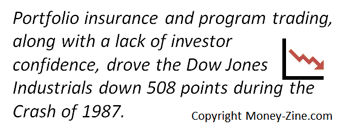Learning about the Stock Market Crash of 1987 is just as important as understanding what happened during the Stock Market Crash of 1929. Many historians argue there were similarities between the two crashes, and that appears to be true. There also seem to be several distinct differences between these historic events.
The Stock Market before October 1987
In the first half of 1987, the U.S. dollar experienced a steep decline in value relative to other world currencies. This made U.S. goods and services less expensive, resulting in a rise in exports. The increase in exports provided U.S. companies with a strong earnings outlook, and a commensurate rise in stock market valuations.
| Additional Resources |
| Stock Market History Stock Market Crash of 1929 Stock Market Crash of 2008 |
In fact, most of 1987 was marked with one stock market record after the other. There had been a great deal of corporate restructuring in the preceding years, and American companies were promising strong future earnings growth. International investors also took notice of the improvements in the U.S. market outlook, and the rate of foreign investment doubled between 1986 and 1987, driving stock prices upward. By August, the Dow Jones Industrials was up over 800 points for the year, which translated into a 41% rise in value. In September 1987, the economic concerns over the weak dollar and rising interest rates started making investors nervous. Volatility in the market increased dramatically as both good and bad economic information was in the news. A record single day point gain for the Dow was set on September 22nd, only to be followed by the largest single day point loss on October 6th. During the three days of October 14th through 16th, the Dow fell over 260 points and the S&P 500 declined 10%. The volatility of the market created a great deal of anxiety over the weekend. Investors were left wondering what would happen on Monday.
October 19, 1987: Black Monday
On Monday October 19, 1987, the stock market plummeted right from the opening bell. No one was looking to buy stocks that day, and the problems in the stock market soon spread to the futures market. The technology advances in the stock exchanges began to kick in, and these computerized systems accelerated the decline.

Program trading was a new tool, and was introduced to take advantage of rapid market movements. On Black Monday, program trading moved millions of shares, and clients as well as investment houses were left wondering what their actual market positions were like for most of the day. Portfolio insurance professionals also contributed to the stock market crash of 1987 through their electronic trading systems. As these computerized systems analyzed the events of the days prior to Black Monday, they flooded the market with sell orders. Portfolio insurance and program trading were intended to help investors take advantage of short-term market fluctuations. Unfortunately, these two systems, along with a lack of investor confidence, drove the Dow Jones down 508 points. This was a 22% decline in value in just a single day. Investors in the stock market would lose over $500 billion on Black Monday.
What Caused the Stock Market Crash of 1987?
Following the stock market crash, the federal government conducted a study of the events of Black Monday. There was a great deal of concern, and interest, in determining the conditions contributing to the stock market's crashing. After examining the findings of those reports, the Securities and Exchange Commission introduced several new measures of control into the stock market in an attempt to prevent a reoccurrence of the events of Black Monday:
Computer Systems: the stock exchanges upgraded their computer systems so they could handle larger trading volumes in a more accurate and controlled manner.
Margin Requirements: the SEC modified the margin requirements in an attempt to lower the volatility of common stocks, stock options, and the futures market.
Circuit Breakers: the New York Stock Exchange and the Chicago Mercantile Exchange introduced the concept of a circuit breaker. The circuit breaker halts trading if the Dow Jones Industrial Average declines a prescribed number of points in a prescribed amount of time.
As the market index rose over the years, the original circuit breaker levels no longer made sense for these stock exchanges. The current rules for the stock market can be found on the NYSE Euronext's website.
Rebounding from the 1987 Crash
On a final note, the market rebounded remarkably following the 1987 stock market crash. The market began a slow and steady climb almost immediately. In fact, before the end of 1989, the Dow Jones Industrials would once again be setting new record highs. Most scholars attribute this rapid rebounding to the fact that the underlying fundamentals of the market were still strong, and the Federal Reserve took quick action in the months following the crash to bolster international confidence in the American economy.
About the Author - The Stock Market Crash of 1987




.jpg)